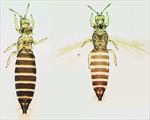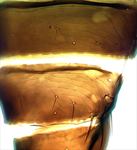
Short-winged and fully-winged females

Head & thorax (winged female)

Antenna

Antennal segment III

Tergites VII–VIII

Mesonotum & metanotum (short-winged female)

Fore wing
Both sexes either fully winged, or micropterous with wing lobe shorter than width of thorax. Female with body brown, yellow markings on head and pronotum; legs yellow, femora with brown markings; antennal segment II brown, I and III–IV paler; fore wing weakly shaded, base pale. Antennae 8-segmented, III & IV each with a forked sense cone. Head wider than long; three pairs of ocellar setae present, pair III arising just outside and slightly longer than side of triangle; postocular setae pair I absent, pair IV slender, not longer than diameter of hind ocellus. Pronotum with 5 pairs of major setae; anteromarginal setae shorter than anteroangulars, one pair of minor setae present medially between posteromarginal submedian setae. Metanotum with 2 pairs of setae at anterior margin, campaniform sensilla present. Fore wing with 2 complete rows of veinal setae. Abdominal tergites V–VIII with paired ctenidia (weakly developed on IV), anterolateral to spiracle on VIII; tergite VIII with no posteromarginal comb. Sternites III–VII without discal setae.
Male smaller and paler than female; sternites III–VII with pore plate transverse and narrow to broadly oval.
There are almost 240 species listed in the genus Frankliniella, with up to 130 further names placed into synonymy (Nakahara, 1997). This high rate of synonymy has been due to the previously unrecognized variability in size and color of so many species. F. fusca is remarkable amongst these species because of the presence of long winged and short winged adults, a phenomenon that is known in only 10, unrelated, species in this genus (Mound et al., 2005).
Recorded from a wide range of plant species, and beeding on leaves as well as in flowers. The dimorphism in wing development might indicate an adaptation to unpredictable ecological conditions, such as in the "fire ecology" areas of Georgia and Florida . This species is important as a pest of field crops (tobacco, peanuts, tomatoes, capsicums) particularly in south eastern USA.
Particularly common in southeastern USA, but widespread across the USA, into Canada and also Puerto Rico, Martinique and Mexico; intercepted in quarantine in Netherlands.
THRIPIDAE - THRIPINAE
Frankliniella fusca (Hinds)
Euthrips fuscus Hinds, 1902: 154
Euthrips nicotianae Hinds, 1905: 198
Scirtothrips owreyi Watson, 1924: 51
Mound LA, Nakahara S & Day MD (2005) Frankliniella lantanae sp.n. (Thysanoptera); a polymorphic alien thripid damaging Lantana leaves in Australia. Australian Journal of Entomology 44: 279–283.
Nakahara S (1997) Annotated list of the Frankliniella species of the world (Thysanoptera: Thripidae). Contributions on Entomology, International 2 (4): 355–389.